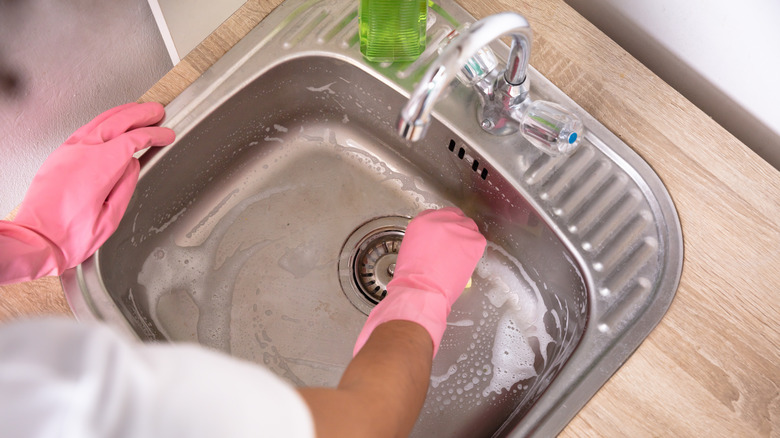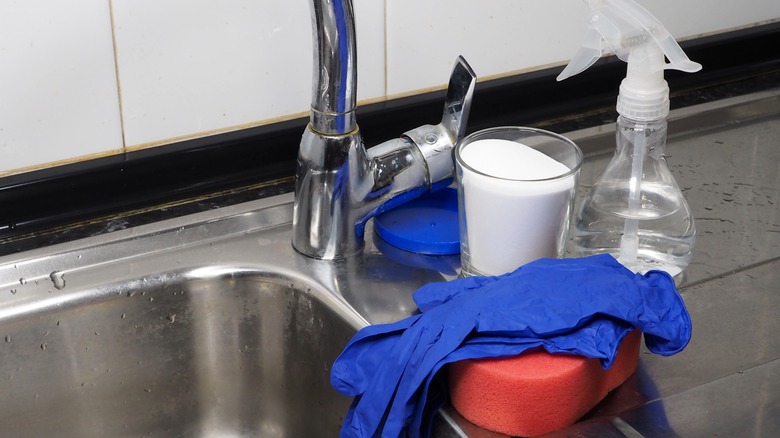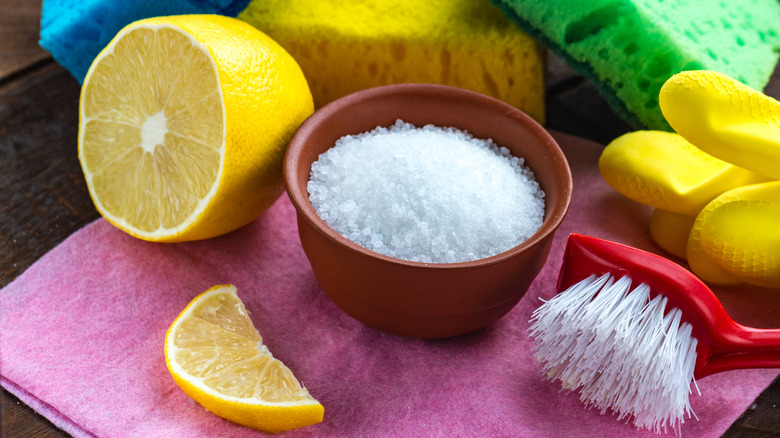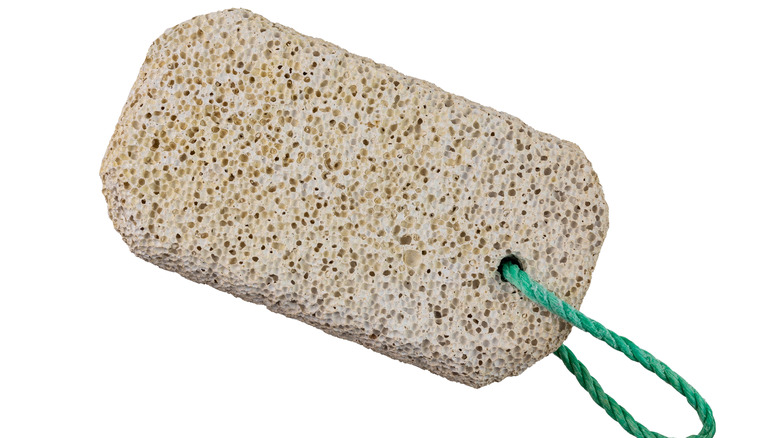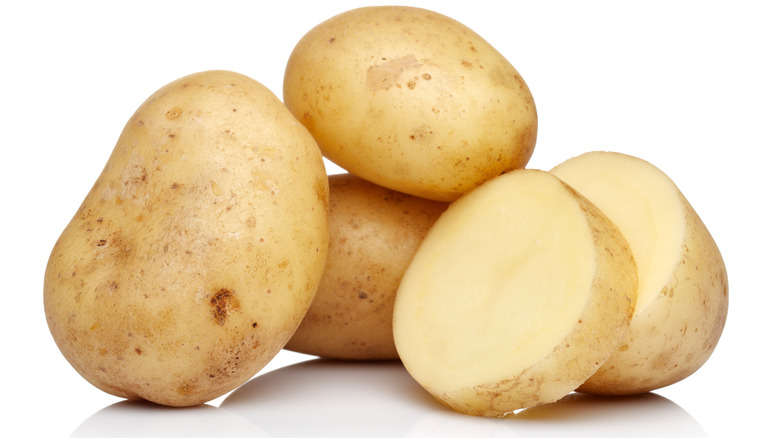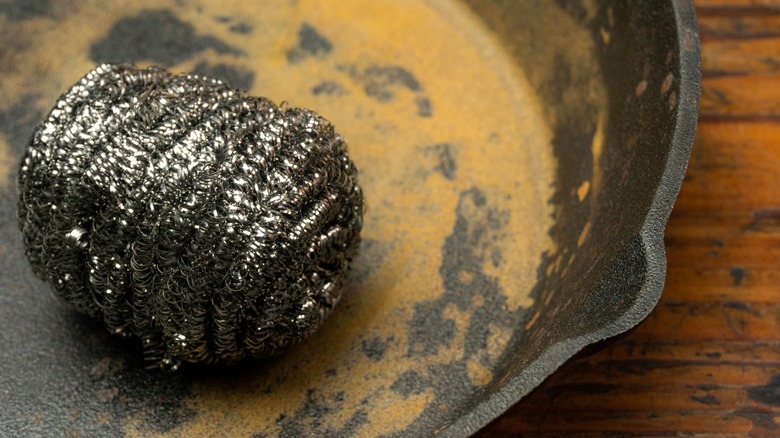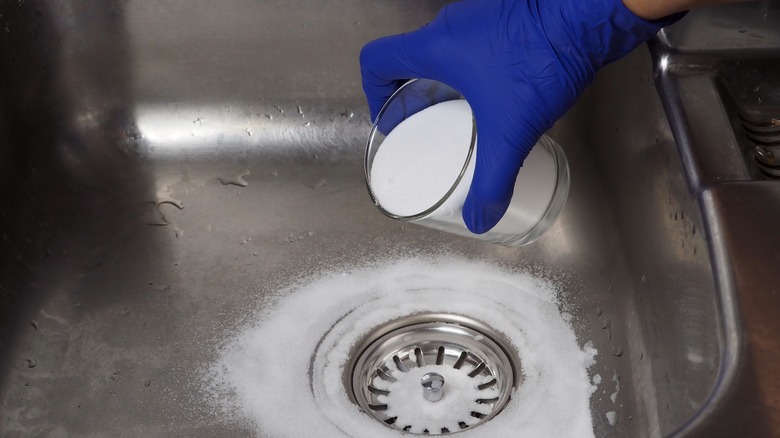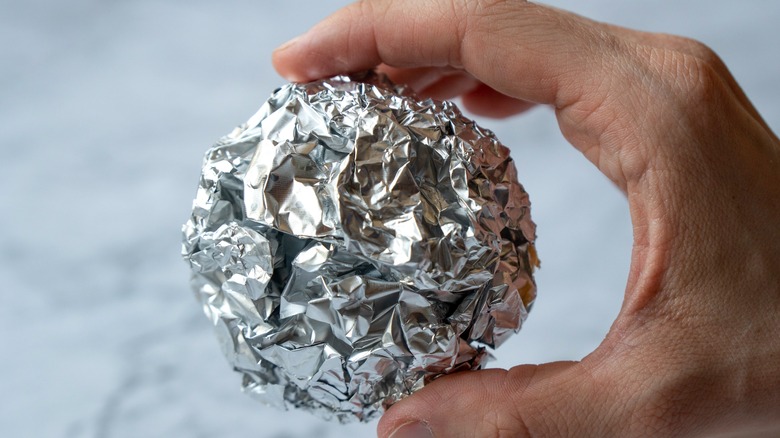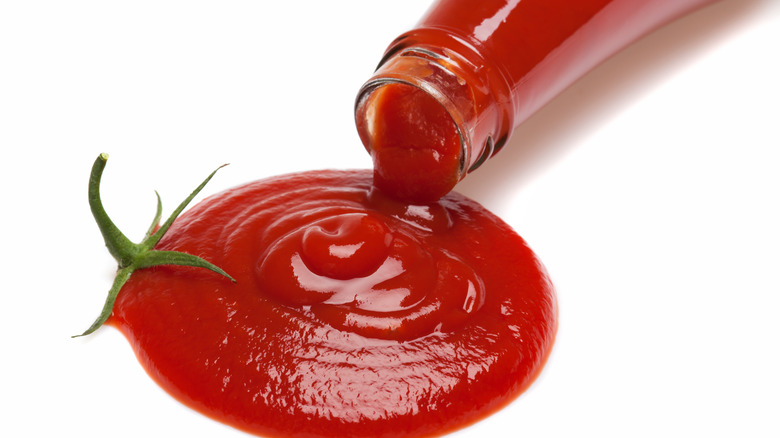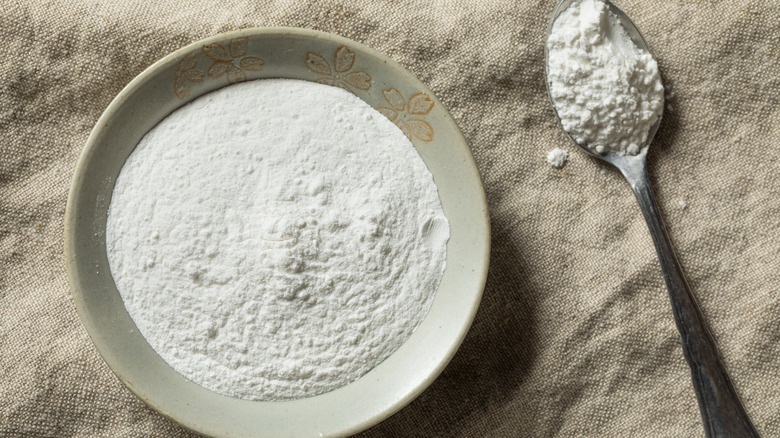Helpful Tricks For Banishing Rust Stains Around Your Kitchen
We may receive a commission on purchases made from links.
You're careful to maintain your kitchen as a clean and healthy place for food prep, cooking, and dining. But on certain surfaces, unsightly rust stains appear due to the combination of water molecules and oxygen on iron or metals that contain iron. In fact, rust stains can develop due to the presence of iron in your area's water. They tend to appear in and around kitchen sinks as well as on cooking utensils, pots and pans, and even large stainless steel appliances .
When you see rust stains in your kitchen, there's no need to go out and spend money on commercially prepared rust removers. Instead, you can mix your own rust-fighting concoctions using common kitchen staples like white vinegar, lemon juice, and baking soda. You might be surprised to learn that unexpected ingredients such as ketchup and cream of tartar can be recruited in the fight against rust stains. Read on to discover numerous rust-removal tricks that utilize inexpensive materials and simple methods. We'll explain why they work as well as the step-by-step procedures to banish rust from the surfaces around your kitchen.
Remove rust from a kitchen sink with white vinegar
Kitchen sinks stay wet much of the time, so it's no surprise that these areas are particularly susceptible to developing rust stains. When you see rust in your stainless steel or porcelain sink, it's time to reach for the white vinegar. The acetic acid in the vinegar produces a chemical reaction called neutralization that results in dissolving the iron oxide and leaving a residue of water-soluble salt. This residue is quickly and easily washed away in the cleaning process to produce a stain-free surface. The ingestible white vinegar that we use for recipes contains 4 percent acetic acid and 96 percent water. By contrast, the white vinegar that is labeled as cleaning vinegar contains up to 7 percent acetic acid with 93 percent water. Either product is effective in cleaning rust stains.
For a stainless steel sink, mix ½ cup of white vinegar with ½ cup of water. Dip a microfiber cleaning cloth into the mixture and use it to scrub away the rust stains. As an alternative, you can sprinkle baking soda onto the surface and add a small amount of full-strength white vinegar. Then, scrub the area with a non-abrasive brush. For a porcelain sink, it's okay to spray full-strength cleaning vinegar onto the surface and scrub it with a nylon-bristle brush. If your countertops are made of granite or other natural stone, be sure to keep the vinegar away from the countertop around the sink. It will cause the stone to erode.
Lemon juice comes to the rescue for rust-stained kitchen sinks
Similar to acetic acid, the citric acid in lemon juice is a well-known rust remover. It reacts with the iron oxide to lift a rust stain away from the surface where it has developed. PubMed measures the citric acid in natural lemon juice at 1.44 grams per ounce and the amount found in lemon juice concentrate at 1.10 grams per ounce. These amounts of citric acid make lemon juice a go-to stain remover that won't damage the underlying surfaces where you apply it.
To employ lemon juice as a stain remover on stainless steel and porcelain sinks, it's best to combine the juice with either salt or baking soda. This provides a mild, natural abrasion for the stained area. One simple method is to cut a lemon in half and dip the pulp side in a dish of salt. Then, use the salted pulp to scrub away the stain. As an alternative, you can make a paste from lemon juice mixed with either salt or baking soda. Leave the lemon-juice-and-salt paste on the rust stain for 15 to 20 minutes before scrubbing with an old toothbrush. If you make the paste from lemon juice and baking soda, allow it to sit for a few hours. Then, simply rinse away the rust stain and dry the sink. For a slightly stronger cleaning solution, it's okay to mix a bit of white vinegar with the lemon juice.
Scrub rust stains in porcelain or ceramic sinks with a pumice stone
You may be familiar with pumice stone as a pedicure tool for smoothing the rough skin on your feet. But did you know it's a handy cleaning tool, as well? While this trick is not for use on stainless steel sinks, it may effectively remove rust stains from porcelain and ceramic sinks. Minerals Education Coalition defines natural pumice stone as a type of igneous rock that forms with the cooling of lava ejected from a volcano. It features an abrasive texture that removes rust stains via friction against hard surfaces like porcelain or ceramic. Be aware that a pumice stone can scratch stainless steel, wood, and the sealant on natural stone countertops.
Using a pumice stone like this option from Amazon to scour rust stains may take some elbow grease, but the procedure is simple. Simply wet the sink surface and wet the pumice stone, then scrub away. You'll see a paste forming as the pumice material gradually dissolves. This paste is lifting the rust stain from the hard porcelain or ceramic surface. Simply rinse it away, and wipe the sink with a soft cloth. If the stain is not completely banished, repeat the process, keeping the pumice stone wet. The pumice stone can be reused, but it will eventually lose its abrasive quality. That's when it's time to replace it.
Oxalic acid from a potato fights rust stains in kitchen sinks and cookware
Potatoes might be on the menu for tonight's dinner, but did you know that you can use one to remove rust stains from the surfaces in your kitchen? It's the oxalic acid content that makes a cut potato an excellent scrubber when you're fighting rust. According to CoreChem, when oxalic acid comes in contact with rust, it causes a chemical reaction called double displacement. In this process, the iron oxide (commonly called rust) changes into iron oxalate, a water-soluble salt that you can easily rinse away.
To use this trick, simply cut a raw potato in half to reveal the fleshy interior of the vegetable. Dip the exposed part in liquid dishwashing soap or baking soda or salt. Then, use it like a scrubbing pad on the rust stain. Follow up by rinsing thoroughly and drying the surface with a clean cloth.
This trick is effective for kitchen sinks, pots and pans, and cooking utensils. On rusty cast-iron cookware, it's a good idea to use kosher salt, rather than dishwashing liquid or baking soda. Simply sprinkle the kosher salt into the pan and scrub it with the potato.
Use stainless steel scrubbing pads on rusty cast iron cookware
Good cooks love cast iron pots and pans for cooking on the stovetop as well as baking in the oven. The material holds heat evenly and produces delicious results for a myriad of recipes from meats to desserts. But iron is susceptible to rusting, and removing rust stains can become a chore if cast iron cookware is neglected over time. The primary goal for cast-iron enthusiasts is to banish rust stains without damaging the surfaces of the cooking vessels. While you can scour a cast iron skillet with steel wool, the harsh and abrasive material will take the pan back to the original raw iron. That means you'll need to start all over again with seasoning the pan.
To remove rust stains from cast iron cookware without ruining the seasoning, it's a good idea to use a stainless steel scrubbing pad such as this one from Amazon. Never put your cast iron cookware or bakeware in the dishwasher. Instead, wash it by hand with regular dish soap, using the stainless steel scrubber. For significant rust, you can soak the pan in a solution of equal parts vinegar and water before you scrub it. Finish the job by rinsing and thoroughly drying the cookware with a clean towel.
Use baking soda with an old toothbrush to scrub away kitchen rust stains
Baking soda is a common and inexpensive ingredient that many people keep around the house. When mixed with water, baking soda creates an alkaline solution that dissolves rust. On top of that, it provides a mildly abrasive texture that's effective for scrubbing multiple surfaces without damaging them.
For example, you can scrub a stainless steel sink with moistened baking soda on an old toothbrush, and you'll remove the stains without scratching the stainless steel. For stubborn stains on a porcelain sink, you might make a paste of baking soda and water to cover the stain and leave it overnight. In the morning, scrub the area with an old toothbrush and rinse away the baking soda. If you need a bit more strength, soak the stain with lemon juice or vinegar for at least 30 minutes. Then, apply the paste of baking soda and water, allowing it to sit for an additional 30 minutes. Finish the job by scrubbing with a soft cloth, rinsing, and drying the surface.
Clean rust from pots, pans, and cooking utensils with aluminum foil
Aluminum foil is a common product found in most kitchens, and people use it for a plethora of tasks from wrapping sandwiches to fashioning robot costumes for Halloween. Among its many uses, aluminum foil removes rust stains by breaking down the iron oxide. My Fix Up Life explains that it works because aluminum is a metal that attracts oxygen, pulling it away from the iron oxide compound commonly known as rust. As an added bonus, aluminum is a soft metal that you can rub on surfaces like stainless steel and chrome without fear of scratching them.
To apply this trick to rusty kitchen utensils, sinks, pots, and pans, simply tear off a sheet of aluminum foil and squish it into a loose ball. Wet the foil with water and scrub the rust stain. As you scrub, you'll see the dark stain transferring onto the aluminum ball. Keep the aluminum wet as you scrub until the rust stain is banished. For added strength, you might wet the aluminum ball with vinegar instead of water. After the rust stain is gone, rinse the clean surface with water and dry it with a soft towel or microfiber cloth.
Grab that bottle of ketchup to remove rust stains from cookware and kitchen tools
When you see rust stains around the kitchen, look no further than your pantry to grab a bottle of ketchup. The acetic acid and salt ingredients that make it one of your favorite condiments for burgers and fries also make ketchup a rust fighter.
To ensure the effectiveness of this trick, you'll need to give the ketchup plenty of time to work on the rust stain. For kitchen utensils and cookware, the best approach is to coat the rust with a thick layer of ketchup and let it sit overnight. If you're in a hurry, give the ketchup at least 3-to-4 hours to lift the stain. Next, wipe away the ketchup with a soft cloth soaked in a solution of equal parts lemon juice and water. Follow up by washing and rinsing with regular dish soap and water. Finally, be sure to dry the item thoroughly with a clean towel. If one treatment does not completely remove a stubborn rust stain, you can repeat the process. After all, it's a cheap and easy way to tackle the rust with very little effort.
Reach into your pantry for the cream of tartar when fighting rust stains in the kitchen
If you love to bake, it's likely that you have a small container of cream tartar on hand in the kitchen. It's a white powder, and its scientific name is potassium bitartrate. Cream of tartar contains tartaric acid, an ingredient that breaks down rust.
The best way to put cream of tartar to work against rust is to mix it with bicarbonate of soda (aka baking soda) in a 1:4 ratio. For example, you can place one tablespoon of cream of tartar in a shallow bowl and add four tablespoons of baking soda. Next, add only enough water to make a thick paste. Spread it on the rust stain, and allow the paste to sit for approximately 30 minutes. Then, wipe the area with a soft cloth and dry it with a clean towel. As an alternative, you can use cream of tartar with just enough hydrogen peroxide to make a paste. In this case, you should leave out the baking soda. After letting the concoction sit on the rust stain for a few hours, you should be able to scrub it off with ease.
